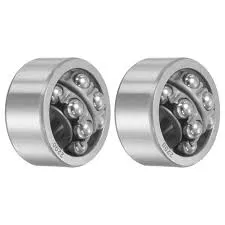
Oct . 05, 2024 18:00 Back to list
parts of a tapered roller bearing
Understanding the Parts of a Tapered Roller Bearing
Tapered roller bearings are widely utilized in various mechanical applications due to their unique design and ability to handle both radial and axial loads simultaneously. A thorough understanding of the components of tapered roller bearings is essential for anyone involved in engineering, manufacturing, or maintenance. This article will provide an overview of the primary parts of a tapered roller bearing, their functions, and their significance.
Main Components of Tapered Roller Bearings
1. Inner Race (Cone) The inner race, often referred to as the cone, is the circular component upon which the tapered roller elements are mounted. The inner surface is designed to accommodate the rolling elements, providing a pathway for them to rotate smoothly. The cone is typically made from high-quality steel to ensure durability and can withstand significant stresses.
2. Outer Race (Cup) The outer race, known as the cup, surrounds the roller elements and provides a stable surface for the tapered rollers to rest against. Like the inner race, it is engineered from robust materials, ensuring longevity and resistance to wear. The cup also helps to maintain the separation and alignment of the roller elements.
3. Tapered Rollers The tapered rollers are the crucial elements that enable the bearing to function effectively. These cylindrical components have a tapered shape that allows them to distribute loads evenly across their surfaces. This design minimizes friction and wear, leading to improved operational efficiency. The arrangement of the rollers helps absorb both radial and axial loads, making the tapered roller bearing versatile for various applications.
4. Cage (Separator) The cage, or separator, holds the tapered rollers in place and maintains their spacing within the bearing. This component is essential for ensuring that the rollers do not come into contact with each other, which would lead to increased friction and premature wear. The cage is typically made from materials such as plastic or metal, depending on the application and load requirements.
5. Seals/Shields Many tapered roller bearings come with seals or shields that protect the internal components from contaminants such as dirt, dust, and moisture. Seals help retain lubrication within the bearing, which is crucial for minimizing friction and wear. The choice of seal or shield type depends on the specific application and environmental conditions the bearing will face.
parts of a tapered roller bearing

6. Lubrication While not a physical part of the bearing, lubrication is critical to the performance and longevity of tapered roller bearings. Grease or oil is used to reduce friction between the rolling elements and the races, minimizing wear and heat generation. Proper lubrication also helps protect against corrosion and extends the lifespan of the bearing.
Importance of Tapered Roller Bearings
Tapered roller bearings are invaluable in numerous industries, including automotive, aerospace, and manufacturing. Their ability to carry heavy loads while maintaining smooth motion makes them indispensable in applications such as wheel hubs, gearboxes, and conveyor systems.
One of the primary advantages of tapered roller bearings is their adaptability. They can accommodate combined loads effectively, making them suitable for applications where axial and radial forces occur simultaneously. This versatility contributes to the efficiency and reliability of machinery, enabling smoother operations and reducing downtime.
Moreover, understanding the individual components of tapered roller bearings can facilitate better maintenance and troubleshooting. For engineers and maintenance personnel, knowing how each part functions and interacts is vital for ensuring optimal performance and addressing potential issues before they lead to failure.
Conclusion
In summary, tapered roller bearings are complex yet efficient components vital to modern machinery. Comprising an inner race, outer race, tapered rollers, a cage, and various lubrication options, each part plays a significant role in the bearing's overall functionality. By recognizing the importance of these components, engineers can enhance the design and maintenance of machinery, leading to improved performance and reliability. As industries continue to evolve, the role of tapered roller bearings will remain a crucial aspect of mechanical engineering and design.
Latest news
-
Grooved Ball Bearing Design and Functionality
NewsJun.04,2025
-
Concrete Mixer Bearing Load Capacity Testing
NewsJun.04,2025
-
6004 Bearing Dimensions in Robotic Joint Designs
NewsJun.04,2025
-
Advantages of Single-Row Deep Groove Ball Bearings
NewsJun.04,2025
-
Applications of Deep Groove Ball Bearings in Automotive Systems
NewsJun.04,2025
-
Innovations in Bearing Pressing Machine Design
NewsJun.04,2025
